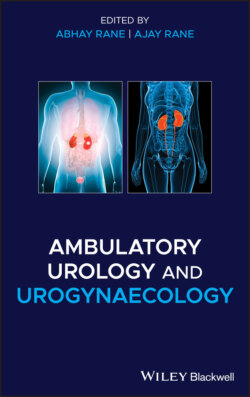Читать книгу Ambulatory Urology and Urogynaecology - Группа авторов - Страница 44
Muscular Support
ОглавлениеThe levator ani muscle and associated connective tissue attachments constitutes the pelvic diaphragm. It has two main components that function as a unit: the diaphragmatic part (iliococcygeus and coccygeus muscles) and the pubovisceral part (puborectalis and pubococcygeus). The pelvic diaphragm is stretched like a hammock from pubis to coccyx and is attached along the lateral pelvic walls to a thickened band in the obturator fascia, the arcus tendineus levator ani (ATLA).
The iliococcygeus spans from the ATLA between pubis and ischial spine (IS) to insert in the midline onto the anococcygeal raphe and the coccyx. The anococcygeal raphe between the anus and coccyx is referred to as the levator plate and provides support to the uterus, upper vagina, and rectum. The coccygeus muscle originates from the IS and inserts on the lateral lower sacrum and coccyx and overlies the sacrospinous ligament. It often blends with the sacrospinous ligament making it difficult to distinguish the two as they both share a common origin and insertion.
The puborectalis arises from the posterior inferior pubic rami and passes posteriorly forming a U‐shaped sling around the vagina, rectum, and perineal body to form the anorectal angle. Some of the fibres of the muscle intermingle with the anal sphincter muscle and contribute to faecal continence. The pubococcygeus has a similar origin, but it inserts in the midline onto the anococcygeal raphe and the anterolateral borders of the coccyx. The openings between the levatorani muscles through which the urethra, vagina, and rectum pass are known as the urogenital hiatus (Figure 2.1).
The pelvic floor muscle fibres maintain resting tone (type I or slow‐twitch fibres) to support the pelvic viscera, and voluntarily contract (type II or fast‐twitch fibres) when required. It is the skeletal component that contracts to help maintain continence in acute stress states such as cough, laugh, or sneeze. Contraction of the levator ani can be assessed and felt as a U‐shaped sling on rectovaginal examination.
The levator ani muscle may get thinner and attenuated with ageing and POP. Neuromuscular injury to the levator, as occurs during childbirth, can lead to widening of the urogenital hiatus, which leads to vertical inclination of the levator plate with resulting pelvic organ dysfunction or POP. Levator avulsion, a documented injury of childbirth, involves the detachment of the puborectalis portion from the pelvic sidewalls. It occurs in about 36% of women after vaginal delivery and about 50–60% after forceps delivery. Avulsion can be diagnosed digitally by palpating the inferior pubic ramus and feeling for the insertion of the puborectalis portion. In the presence of levator avulsion, 2–3 cm lateral to the urethra, the bony surface of the pubic ramus can be palpated devoid of the muscle.
Figure 2.1 Levator ani muscle –pubococcygeus, puborectalis, and iliococcygeus.
The perineal body is an important structure that supports the distal vagina and maintains normal rectal function. Lying between the distal vagina and anus, it provides insertion of bulbospongiosus, superficial, and deep transverse perineal muscles, external anal sphincter, perineal membrane, distal part of rectovaginal fascia (RVF), pubococcygeus and puborectalis portions of the levator ani. Surgical reconstruction of perineum (perineorrhaphy) requires proper approximation of these muscles in order to restore the normal function of perineal body (Figure 2.2).
The perineal membrane (formerly known as the urogenital diaphragm) is a thick fibromuscular sheet that stretches across the anterior urogenital triangle. It attaches laterally to the ischiopubic rami and has a free posterior margin with anchorage at the perineal body. The urethra and vagina pass through the hiatus in the perineal membrane. The perineal membrane therefore fixes the distal urethra, distal vagina, and the perineal body to the bony pelvis at the ischiopubic rami. The superficial perineal space lies external to the perineal membrane and contains the superficial perineal muscles, ischiocavernosus muscle, bulbospongiosus muscle, and superficial transverse perineal muscles.
Figure 2.2 Perineal body with its muscular attachments.
The deep perineal pouch lies between the perineal membrane and levator ani and contains the external urethral sphincter, the compressor urethra, urethrovaginalis, and the deep transverse perineal muscles (Figure 2.3).
